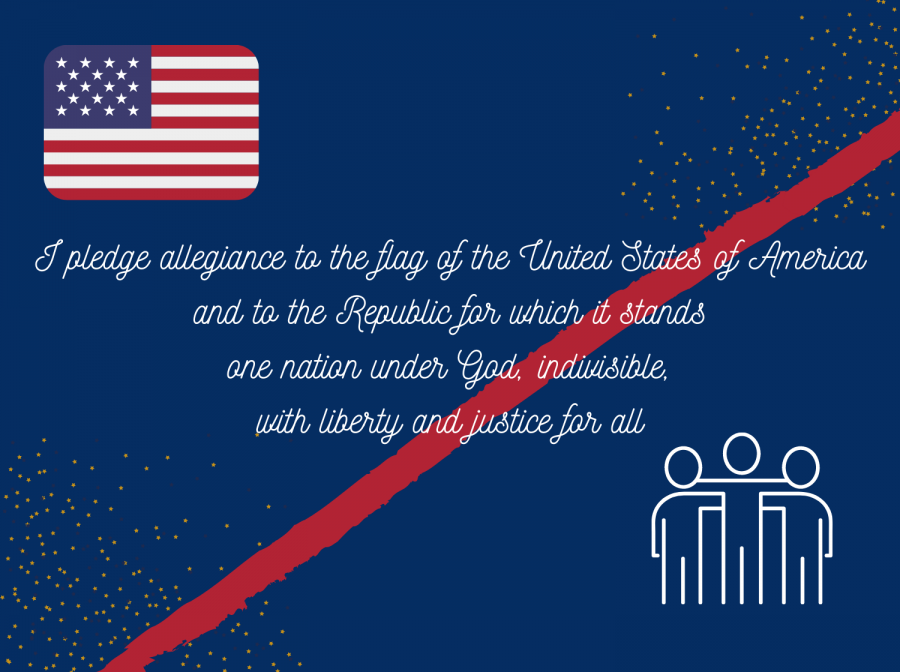On the Pledge of Allegiance: can we stand for better?
Does the Pledge of Allegiance reflect our current values as a nation?
I remember my first encounter with the Pledge of Allegiance. A five-year-old Sage sat cross-legged before her Kindergarten teacher. The woman sounded out each line; the class recited. Could we even pronounce ‘indivisible’ back then?
I never thought too deeply about the pledge — I assumed it was a proclamation of gratitude for my free, American education. So I’ve stood up day after day, because I am grateful for these thirteen years of public school. Though I admire this interpretation, I think we ought to know the pledge’s reality; in other words, the beliefs of its author, the circumstances it grew out of, and most importantly, if it stands the test of time.
The Pledge of Allegiance started in the late nineteenth century when a family magazine employed Francis Bellamy, former Baptist pastor, to create a patriotic program for public schools around the country. The idea began in celebration of the 400th anniversary of Columbus’s arrival in America.
Bellamy’s project sought to define “true Americanism” during a time when immigration into the U.S. soared. Most immigrants were not received well, particularly those who arrived from Southern and Eastern Europe. Bellamy thought the newcomers with darker complexions, foreign tongues and religions other than Christianity were of a lower “racial standard.” As opposed to Northern and Western Europeans, he viewed these people as unassimilable and the antithesis of white, Protestant American culture. Bellamy’s perspective does reflect a larger sentiment, as evidenced by the numerous exclusionary immigration laws passed by Congress — the Chinese Exclusion Act of 1882 and the Immigration Act of 1891, to name a few.
On another note, the pledge emerged after the Civil War which helps explain its focus on indivisibility and pride in the U.S. flag. In fact, during the war itself, people suspected of disloyalty to the Union could write an “oath of allegiance” as a means of avoiding punishment.
The Pledge of Allegiance didn’t become a staple of the American school day until the U.S. engaged in more international conflict — namely the Spanish-American War and World War I. The country entered a sort of ‘patriotic frenzy’ that sought to instill loyalty within its citizens. As a result, use of the pledge had become somewhat mandatory by the 1930s. Later on, the phrase “under God” was added in response to the “godless Communism” that Americans feared during the Cold War.
The Pledge of Allegiance is a product of increased ‘drive toward tradition’ (as phrased by author Jack David Eller) amid hot and cold wars and a changing American population.
Given its backstory, I question if I can stand for it again.
What I find most difficult about this argument is that the language of the pledge is not overtly nativist or political. Taken at face-value, it’s a harmless patriotic salute. But I’m choosing to read between the lines. For instance, I now understand that the phrase “liberty and justice for all,” according to the original author’s sentiments, meant anything but “all.” And it still doesn’t in the wake of Black Lives Matter and attacks on many other communities.
The most common reasoning I see in favor of the pledge frames it as a recognition of the lives that were lost in various wars meant to protect American freedoms. By refusing the pledge, you are refusing your respect. But the speech was not created to honor our veterans. As I see it, the Pledge of Allegiance arose from a widespread defense against the diversification of America, both in people and ideology. It was written as an opposition to what was perceived as un-American: ethnic immigrants, threats to capitalism, non-Christians and the like.
If not the pledge, then what? I’m not convinced we should keep tradition for the sake of ‘tradition’ if it no longer reflects our current state of affairs. I believe we can create new traditions. One option is to replace the pledge, perhaps by holding a national contest through which our many ethnicities can be included. Our new recitation can come from a place of hope instead of fear for America.
Of course, it is remarkable how thirty-one words can capture so much of our history and developing culture. Rather than continue to say them, however, maybe it’s time to retire this inculcation to the history books.







Renee Ricks • Jun 5, 2021 at 12:04 am
Great article Sage! I can relate to so much of what you laid out here. As an African American and a second generation immigrant it is very difficult for me to recite the pledge of allegiance or take it seriously when I know that liberty and justice are NOT for all.
Irene Bond • Jun 3, 2021 at 2:28 pm
Great article Sage. My daughter was forced to stand in first grade when we moved here from another country. She didn’t understand why everyone was doing it, it held no meaning for her as a six-year old, and she couldn’t remember all the words, which made her feel stupid compared to her peers.
We moved to another school, which did not use flag or the Pledge to ‘show’ good citizenship. Rather it attempted to foster a sense of community and commitment to one’s fellow humans through acts of generosity, taking care of the school environment, and encouraging projects designed to contribute to the town we lived in.
The efforts in the early 20th century to create a homogenous national identity had many flaws as you point out, and we’re still dealing with those flaws today.